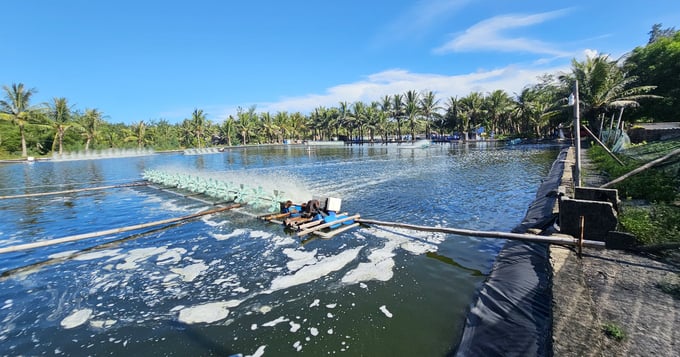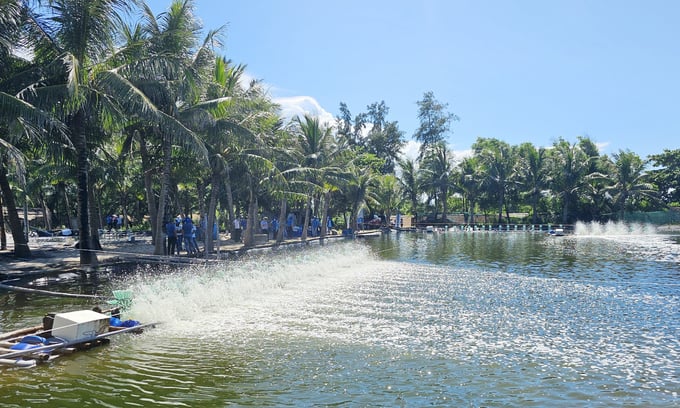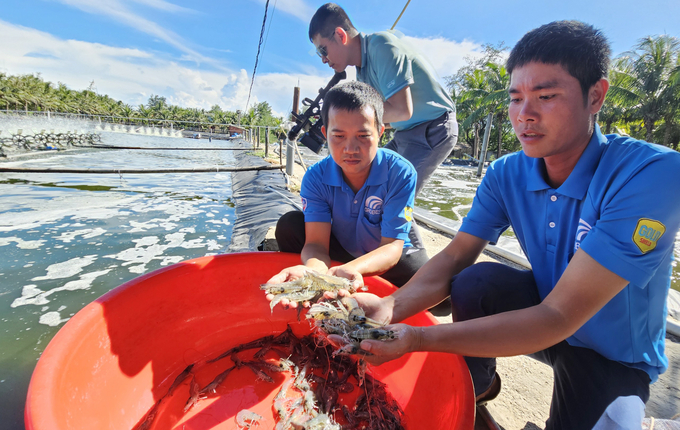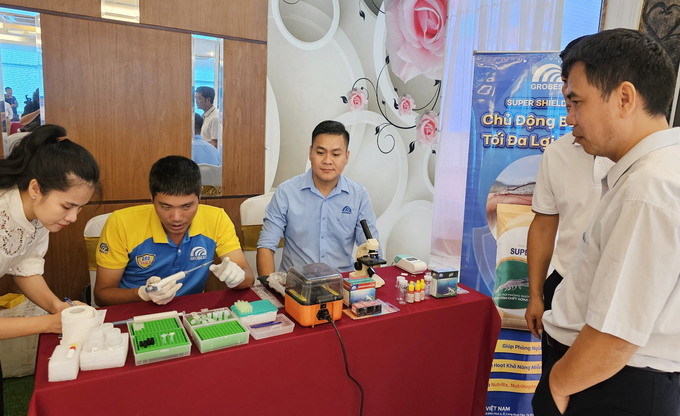In two days from 23 to 24/7, the National Center for Agricultural Extension (KNQG) in Dong Hoi City (Quang Binh) in cooperation with the Ministry of Agriculture and Rural Development of Quang Binh organized the Agricultural Extension Forum @ Agriculture with the theme “Applying Solutions and Technical Advances for Sustainable Development of Shrimp Farming in Some Central Coastal Provinces”.
The forum was attended by heads of the National Agriculture and Fisheries Center, Ministry of Fisheries (Ministry of Agriculture and Rural Development), Ministry of Agriculture and Rural Development of Quang Binh, Fisheries Subdivisions, Agricultural and Fisheries Extension Centers of North-Central Provinces, as well as organizations and individuals involved in shrimp farming in some places.

Shrimp pond using Grofarm technology in Hong Thuy commune (Le Thuy district, Quang Binh). Picture: Tam Phung.
In recent years, Vietnam’s shrimp industry has overcome difficulties and challenges to become a spearhead of the industry, making important contributions to the country’s agriculture and economy. Our country’s shrimp export turnover set a record in 2022, reaching US$4.3 billion, up 11.2% compared with 2021. In 2023, our country has set a target of over US$4.3 billion in shrimp export sales.
Through a series of projects and programs, the National Science and Technology Center has currently implemented shrimp farming projects, such as: application of cutting-edge technology, circulatory shrimp farming technology, shrimp intercropping, organic farming, VietGAP, etc. This will help shrimp farmers move towards sustainable and high-efficiency production.
At the forum, the delegates heard representatives from authorities, entities, companies and municipalities presenting a series of presentations on the current situation, solutions and orientations for sustainable development of brackish shrimp farming in Vietnam in general and the Central Coast Provinces in particular. The introduction of numerous breeding models is supported and effectively implemented in the direction of environmental protection, reduction of CO2 emissions in shrimp farming; Difficulties and benefits of advising and evaluating VietGAP certification for the brackish water shrimp farming model…

Delegates saw the model of white leg shrimp farming on sand using Grofarm technology. Picture: Tam Phung.
The forum also spent most of its time allowing state agricultural administrations, organizations, enterprises and shrimp farmers to exchange and discuss to effectively apply solutions and technical advances for sustainable development of shrimp farming in a number of central coastal provinces.
According to Mr. Hoang Van Hong, deputy director of the Center for National Agriculture, the forum has an important meaning as it proposes and finds solutions to promote the development of shrimp farming in the central provinces into a large-scale commodity production industry, thereby contributing to the improvement of production, value and sustainable development.
This is also an opportunity to help shrimp farmers increase their awareness and knowledge, and regularly update new information on scientific and technical advances in hatchling production and brackish water shrimp farming.
At the forum, delegates concluded that by providing technological solutions, the National KN Center has truly become a bridge between businesses and shrimp production facilities and farmers. In particular, it has typically worked with Grobest Vietnam Company to provide and select the best technology solutions, which can then be transferred to shrimp farming households in coastal provinces across the country.
Shrimp farmers in Quang Binh province have also actively learned and applied many scientific and technical advances in shrimp farming, such as:
In 2022, Quang Binh province will occupy 1,480 hectares of brackish shrimp, with a harvest of nearly 4,200 tons. In the 2023 plan, Quang Binh will farm nearly 1,500 hectares, of which the white leg shrimp area is over 1,200 hectares and the black tiger shrimp area is over 280 hectares.

Check the quality of the farmed shrimp after two months of storage. Picture: Tam Phung.
“Quang Binh Province has also actively promoted and mobilized shrimp farmers to focus on building a model of cooperative groups and community groups to raise awareness of disease prevention, protect the environment, and support each other in the production and consumption of products. Shrimp farmers are instructed to use effective production processes such as B. the process of shrimp farming with limited chemicals, the breeding process of 2-3 stages of shrimp production and the direction of mass crewing, and VietG., reduce production costs, ensure traceability…”, Mr. Loi emphasized.
During the forum, delegates visited the Vannamei shrimp farming model at Mr. Tran Anh Duc’s farm in Hai Ninh Township (Quang Ninh District, Quang Binh Province).

Grobest Vietnam Company’s mobile laboratory technology supports shrimp farmers and helps to detect and diagnose diseases through microscopy. Picture: Tam Phung.
Duc’s shrimp farm consists of a system of 7 ponds (each with an area of 2,500 m2 to 3,500 m2). Thanks to the application of new technologies, pond efficiency has recently been very high. Mr. Duc said that the process of shrimp farming is carried out with new technology supported by Grobest Vietnam Company, from water treatment to seed and feed selection to disease prevention by microscopy methods, etc., so the success rate is very high.
“Five shrimp crops in a row, I’ve had a yield of over 40 tons/ha/year. After deducting expenses, the annual profit is about 2 billion dong. The application of this new agricultural technology gives us security in production,” said Mr. Duc.
In Quang Binh Province, shrimp farming is considered to be the main pillar of aquaculture development with concentrated shrimp farming areas, high-tech agriculture in Ngu Thuy and Ngu Thuy Bac communes (Le Thuy district), Trung Trach and Dai Trach (Bo Trach district), Hai Ninh (Quang Ninh district); intensive and semi-intensive farming in Quang Tho District (Ba Don City), in Quang Xuan Township (Quang Trach District), in Vo Ninh Township (Quang Ninh District) …

